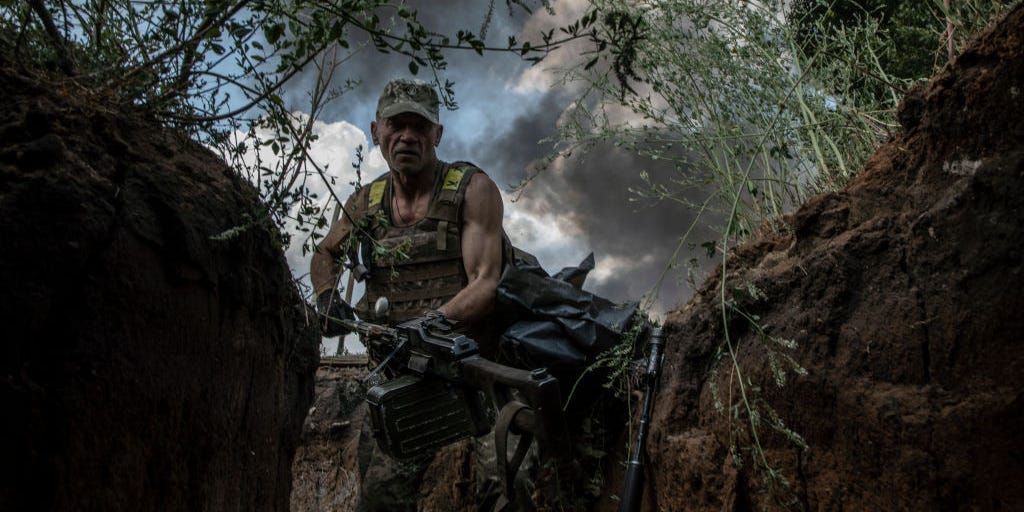Russia Built Fake Explosive Trench Traps to Lure in Ukrainian Troops
Russia has created layers of formidable defenses and fortifications to hold off Ukrainian advances.
Among them are fake trenches designed to lure Ukrainians into a death trap, researchers found on a recent Ukraine trip.
These obstacles are among the many challenges standing in the way of the Ukrainian counteroffensive.
Get the inside scoop on today’s biggest stories in business, from Wall Street to Silicon Valley — delivered daily. Loading Something is loading. Thanks for signing up! Access your favorite topics in a personalized feed while you're on the go. download the app Email address By clicking ‘Sign up’, you agree to receive marketing emails from Insider as well as other partner offers and accept our Terms of Service and Privacy Policy
Ukrainian forces know how to clear a trench. In fact, we've seen them do it flawlessly. But what happens when a trench isn't a trench?
Russian forces built a vast, complex network of trenches and other battlefield obstacles, such as anti-tank barriers and minefields, ahead of Ukraine's counteroffensive.
And while many of the trenches are actual Russian combat positions, others have been traps, researchers learned from front-line Ukrainian forces.
Russia's military "has continued to adapt," Michael Kofman, a leading Russia expert at the Center for Naval Analyses, said in a War on the Rocks podcast discussion published Thursday following a recent trip to Ukraine with other war experts.
"They build out fake trenches. They have mine trenches," Kofman said, explaining that they attempt to "lure Ukrainian forces into trenches that have been mined" with remote-activated mines "and then blow up the mines."
"Once forces jump into them, they have parts of trenches that are intentionally empty," he said, characterizing it as an attempt "to get Ukrainians into those trenches, to then essentially blow them up."
A paratrooper from the 81st Airmobile Battalion takes shelter in a trench from a BM-21 Grad multiple rocket launcher attack which has destroyed a neighboring house on July 5,2022 in Seversk, Ukraine. Laurent van der Stockt for Le Monde/Getty Images
Clearing a trench is a difficult battlefield task that requires a coordination of artillery and maneuver forces.
A recent video released by Ukrainian special forces showed a trench-clearing operation in which the Russians were caught off guard and defeated by Ukrainians using well executed tactics, but not every battle is guaranteed to go their way.
The possibility that the trench Ukrainian infantry are rushing into might be an explosive trap makes things immensely more difficult.
Kofman said that the kinds of adaptations happening in the Russian military go beyond routine defense.
From his conversations with Ukrainian military personnel on the front lines, which he got close to during his visit, he was able to learn that Russia is also doing tricky things like stacking anti-tank mines in order to tear up mine-clearing vehicles able to withstand the explosive force produced by one or two mines but not necessarily more than that.
Russia "is doubling, tripling them up," he said of the anti-tank mines. Russian approaches put "high-value targets" Ukraine cannot afford to lose at risk, threatening their survivability.
When it comes to land mines, others in Ukraine have observed some similar tricks by the Russians.
Ryan Hendrickson, a former US Army Special Forces Engineer who cleared improvised explosives in Afghanistan and is now working as a volunteer removing mines in Ukraine, talked with Ukrainian Toronto Television this week about some of the schemes he and his team have encountered.
Hendrickson said they have come across extremely complex minefields in which anti-tank mines are protected by anti-personnel mines and other explosives surrounded by booby traps.
The purpose of a setup like this is to maim or kill anyone involved in the de-mining process.
Paratroopers from the 81st Airmobile Battalion come out from a trench after a attack from a BM-21 Grad multiple rocket launcher on July 5,2022 in Seversk, Ukraine. Laurent van der Stockt for Le Monde/Getty Images
But when it comes to the Ukrainian counteroffensive, Russian land mines — which in addition to killing troops directly also slow advancing forces and expose them to enemy artillery, missiles, and airstrikes — are only part of the problem.
Standing in the way of a Ukrainian breakthrough, the Russian military has regular forces, motor rifle units, Spetsnaz units, and so on holding the lines, Kofman explained. They have a lot of artillery, and the Russian "entrenchments include incredibly dense minefields, anti-tank and anti personnel [mines] layered upon each other."
Russia also has a lot of anti-tank weaponry deployed on the forward lines, as well as drones, particularly one-way Lancet drones, and loitering munitions. They also have attack helicopters that have put dents in the Ukrainian offensive.
"And they've dug in extensively in terms of cementing fortifications, having bunkers, having tunnels in some parts of the main line," Kofman said, pointing out this formidable defense has been months in the making.
And key challenges for the Ukrainians as they face off against these defenses is a lack of the kind of weaponry they need most, as well as their inability to execute combined arms operations at scale.
Franz-Stefan Gady, an expert at the Center for New American Security who also recently visited Ukraine for research, said that in this situation, "absent a sudden collapse of Russian defenses," he suspects that "this will remain a bloody attritional fight with reserve units being fed in incrementally."
"I think this offensive," Kofman said in the podcast discussion of ongoing developments in Ukraine and the push to batter the Russian lines, "is likely to go on not just for weeks, but for months."
"I think it's going to see this extensive attritional phase with grinding fighting with incremental gains by Ukrainian forces, and that it's going to require a great deal of artillery ammunition and adaptation," he continued, adding "it's very difficult to conduct an offensive like this against a well-prepared defense."
Source: Business Insider


